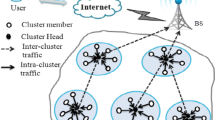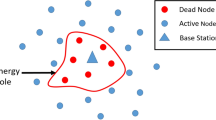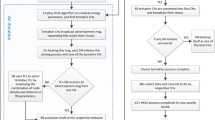Abstract
Wireless sensor networks (WSNs) have variety of applications and comprise of numerous tiny sensor nodes that are deployed to process and transmit the sensed data to the base station. Security and energy efficiency are the two major concerns for prolonging the lifetime of the WSN. Due to their broadcast nature, WSNs are prone to several threats that needs to be resolved. An effective clustering scheme can overcome these security threats and enhance the energy efficiency as well as lifetime of the network. A secured and energy efficient Intelligent and Secured Fuzzy Clustering Algorithm using Balanced Load Sub-cluster formation (ISFC-BLS) routing protocol for WSNs is proposed and corresponding maintenance methods and routing algorithms are established. On the basis of previous works, in order to select cluster heads in hierarchical topology, in this paper, a solution based on fuzzy based clustering technique is proposed which facilitates cooperative communication in the network and the balanced load sub cluster formation is proposed that helps to determine the nodes which joins the cluster. Ant colony optimization is used for determining the optimal path to the destination. Experimental results and performance analysis demonstrate that ISFC-BLS is more effective and secure than energy efficient heterogeneous ring clustering and other existing clustering techniques, for enhancing the networks lifetime and achieving better energy efficiency by decreasing the number of control messages and the node energy consumption.











Similar content being viewed by others
References
Bhatti, S., Xu, J., & Memon, M. (2011). Clustering and fault tolerance for target tracking using wireless sensor networks. IET Wireless Sensor Systems,1(2), 66–73.
Li, W., & Zhang, W. (2012). Sensor selection for improving accuracy of target localisation in wireless visual sensor networks. IET Wireless Sensor Systems,2(4), 293–301.
Azharuddin, M., Kiula, P., & Jana, P. K. (2013). A distributed fault tolerance clustering algorithm for wireless sensor networks. In IEEE international conference advances computing, communications and informatics, Mysore, India, pp. 997–1002.
Wang, X., Sheng, M., Liu, M., Zhai, D. S., & Zhang, Y. (2013). RESP: A k-connected residual energy-aware topology control algorithm for ad hoc networks. In IEEE wireless communications and networking conference, Shanghai, China, pp. 15–36.
Ding, X., Sun, X. J., Huang, C., & Wu, X. B. (2016). Cluster-level based link redundancy with network coding in duty cycled relay wireless sensor networks. Computer Networks,99(C), 15–36.
Rafeh, R. (2014). Proposing a distributed fault detection algorithm for wireless sensor networks. Soft Computing Journal,2(2), 26–35.
Saleh, S., Ahmed, M., Ali, B. M., Rasid, M. F. A., & Ismail, A. (2013). A survey on energy awareness mechanisms in routing protocols for wireless sensor networks using optimization methods. Transactions on Emerging Telecommunications Technologies. https://doi.org/10.1002/ett.2679.
Han, G., Jiang, J., Guizani, M., & Rodrigues, J. J. P. C. (2016). Green routing protocols for wireless multimedia sensor networks. IEEE Wireless Communications,23, 140–146.
Hayes, T., & Ali, F. H. (2016). Location aware sensor routing protocol for mobile wireless sensor networks. IET Wireless Sensor Systems,6(2), 49–57.
Radi, M., Dezfouli, B., Bakar, K. A., & Lee, M. (2012). Multipath routing in wireless sensor networks: Survey and research challenges. Sensors,12(1), 650–685.
Teng, Z., Xu, M., & Zhang, L. (2016). Nodes deployment in wireless sensor networks based in improved reliability virtual force algorithm. Journal of Northeast Dianli University,36(2), 86–89.
Sun, Z., & Zhou, C. (2016). Adaptive cluster algorithm in WSN based on energy and distance. Journal of Northeast Dianli University,36(1), 82–86.
Aslam, M., Javaid, N., Rahim, A., Nazir, U., Bibi, A., & Khan, Z. (2012). Survey of extended LEACH-based clustering routing protocols for wireless sensor networks. In Proceedings of 9th IEEE international conference on embedded software system, proceedings of 14th international conference on high performance computing communications (HPCC-ICESS), pp. 1232–1238.
Ritchie, L., Yang, H.-S., Richa, A. W., & Reisslein, M. (2006). Cluster overlay broadcast (COB): MANET routing with complexity polynomial in source-destination distance. IEEE Transactions on Mobile Computing,5(6), 653–667.
Goswami, D., & Chaturvedi, A. (2012). Cross layer integrated approach for secured cluster selection in ad hoc networks. International Journal of Computer and Communication Engineering,1(3), 187–190.
Agarwal, R., Gupta, R., & Motwani, M. (2012). Review of weighted clustering algorithms for mobile ad hoc networks. Computer Science & Telecommunications,33(1), 71–78.
Chauhan, H. S. (2013). Comparative study of clustering based algorithm in mobile ad-hoc network. International Journal of Recent Technology and Engineering (IJRTE),2(3), 110–113.
Al-Ahmadi, S., & Al-Dhelaan, A. (2014). AMHC: Adaptive Multi-hop clustering based resource discovery architecture for large scale MANETs. Research Journal of Applied Sciences Engineering and Technology,7(17), 3571–3581.
Vlajic, N., & Xia, D. (2006). Wireless sensor networks: To cluster or not to cluster? In Proceedings of international symposium on world wireless, mobile multimedia network, pp. 258–268.
Karaboga, D., Okdem, S., & Ozturk, C. (2012). Cluster based wireless sensor network routing using artificial bee colony algorithm. Wireless Network,18(7), 847–860.
Zhu, X., Shen, L., & Yum, T.-S. (2009). Hausdorff clustering and minimum energy routing for wireless sensor networks. IEEE Transactions on Vehicular Technology,58(2), 990–997.
Chamam, A., & Pierre, S. (2010). A distributed energy-efficient clustering protocol for wireless sensor networks. Computers & Electrical Engineering,36(2), 303–312.
Dimokas, N., Katsaros, D., & Manolopoulos, Y. (2010). Energyefficient distributed clustering in wireless sensor networks. Journal of Parallel and Distributed Computing,70(4), 371–383.
Wei, D., Jin, Y., Vural, S., Moessner, K., & Tafazolli, R. (2011). An energy-efficient clustering solution for wireless sensor networks. IEEE Transactions on Wireless Communications,10(11), 3973–3983.
Wang, A., Yang, D., & Sun, D. (2012). A clustering algorithm based on energy information and cluster heads expectation for wireless sensor networks. Computers & Electrical Engineering,38(3), 662–671.
Heinzelman, W. B., Chandrakasan, A. P., & Balakrishnan, H. (2002). An application-specific protocol architecture for wireless microsensor networks. IEEE Transactions on Wireless Communications,1(4), 660–670.
Bandyopadhyay, S., & Coyle, E. J. (2003). An energy efficient hierarchical clustering algorithm for wireless sensor networks. IEEE INFOCOM 2003. Twenty-second annual joint conference of the IEEE computer and communications societies (IEEE Cat. No.03CH37428). https://doi.org/10.1109/infcom.2003.1209194.
Kang, S. H., & Nguyen, T. (2012). Distance based thresholds for cluster head selection in wireless sensor networks. IEEE Communications Letters,16(9), 1396–1399.
Taheri, H., Neamatollahi, P., Younis, O. M., Naghibzadeh, S., & Yaghmaee, M. H. (2012). An energy-aware distributed clustering protocol in wireless sensor networks using fuzzy logic. Ad Hoc Networks,10(7), 1469–1481.
Chamam, A., & Pierre, S. (2010). A distributed energy-efficient clustering protocol for wireless sensor networks. Computers & Electrical Engineering,36(2), 303–312.
Dimokas, N., Katsaros, D., & Manolopoulos, Y. (2010). Energyefficient distributed clustering in wireless sensor networks. Journal of Parallel and Distributed Computing,70(4), 371–383.
Wei, D., Jin, Y., Vural, S., Moessner, K., & Tafazolli, R. (2011). An energy-efficient clustering solution for wireless sensor networks. IEEE Transactions on Wireless Communications,10(11), 3973–3983.
Heinzelman, W. R., Chandrakasan, A., & Balakrishnan, H. (2000). Energy efficient communication protocol for wireless microsensor networks. In Proceedings of 33rd annual Hawaii international conference system science.
Manjeshwar, A., & Agrawal, D. P. (2001). TEEN: A routing protocol for enhanced efficiency in wireless sensor networks. In Proceedings of 15th IPDPS, Vol. 1, p. 189.
Smaragdakis, G., Matta, I., & Bestavros, A. (2004). SEP: A stable election protocol for clustered heterogeneous wireless sensor networks. Department of Computer Science, Boston Univiversity, Boston, MA, USA, Technical Report BUCS-TR2004-022.
Qing, L., Zhu, Q., & Wang, M. (2006). Design of a distributed energy-efficient clustering algorithm for heterogeneous wireless sensor networks. Computer Communications,29(12), 2230–2237.
Joseph, A. J., & Hari, U. (2013). Hexagonally sectored routing protocol for wireless sensor networks. International Journal of Engineering,2(5), 1249–1252.
Wang, S.-S., & Chen, Z.-P. (2013). LCM: A link-aware clustering mechanism for energy-efficient routing in wireless sensor networks. IEEE Sensors Journal,13(2), 728–736.
Ma, C., Wang, L., Xu, J., Qin, Z., Shu, L., & Wu, D. (2013). An overlapping clustering approach for routing in wireless sensor networks. In Proceedings of IEEE wireless communication and networking conference (WCNC), pp. 4375–4380.
Zhang, W., Li, L., Han, G., & Zhang, L. (2017). E2HRC: An energy-efficient heterogeneous ring clustering routing protocol for wireless sensor networks. Special Section On Future Networks: Architectures, Protocols, and Applications, IEEE Access,5, 1702–1713.
Author information
Authors and Affiliations
Corresponding author
Additional information
Publisher's Note
Springer Nature remains neutral with regard to jurisdictional claims in published maps and institutional affiliations.
Rights and permissions
About this article
Cite this article
Bhushan, B., Sahoo, G. ISFC-BLS (Intelligent and Secured Fuzzy Clustering Algorithm Using Balanced Load Sub-Cluster Formation) in WSN Environment. Wireless Pers Commun 111, 1667–1694 (2020). https://doi.org/10.1007/s11277-019-06948-0
Published:
Issue Date:
DOI: https://doi.org/10.1007/s11277-019-06948-0




